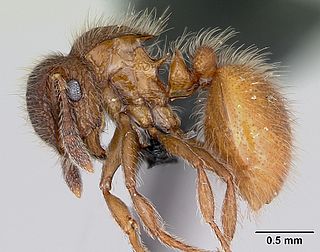
The Formicinae are a subfamily within the Formicidae containing ants of moderate evolutionary development.

Ponerinae, the ponerine ants, is a subfamily of ants in the Poneromorph subfamilies group, with about 1,600 species in 47 extant genera, including Dinoponera gigantea - one of the world's largest species of ant. Mated workers have replaced the queen as the functional egg-layers in several species of ponerine ants. In such queenless species, the reproductive status of workers can only be determined through ovarian dissections.

Myrmicinae is a subfamily of ants, with about 140 extant genera; their distribution is cosmopolitan. The pupae lack cocoons. Some species retain a functional sting. The petioles of Myrmicinae consist of two nodes. The nests are permanent and in soil, rotting wood, under stones, or in trees.

Dolichoderinae is a subfamily of ants, which includes species such as the Argentine ant, the erratic ant, the odorous house ant, and the cone ant. The subfamily presents a great diversity of species throughout the world, distributed in different biogeographic realms, from the Palearctic, Nearctic, Afrotropical region and Malaysia, to the Middle East, Australian, and Neotropical regions.

Aphaenogaster is a genus of myrmicine ants. About 200 species have been described, including 18 fossil species. They occur worldwide except in South America south of Colombia, sub-Saharan Africa, and Antarctica.

Crematogaster is an ecologically diverse genus of ants found worldwide, which are characterised by a distinctive heart-shaped gaster (abdomen), which gives them one of their common names, the Saint Valentine ant. Members of this genus are also known as cocktail ants because of their habit of raising their abdomens when alarmed. Most species are arboreal (tree-dwelling). These ants are sometimes known as acrobat ants.

Megalomyrmex is a genus of ant in the subfamily Myrmicinae. The genus is known only from the Neotropics, where some of the species are specialized parasites or predators of Attini.

Anochetus is a genus of small, carnivorous ants found in the tropics and subtropics throughout the world.

Myrmecina is a genus of ants in the subfamily Myrmicinae. It contains 53 species distributed in North America, Europe, northern Africa, India east, Korea, Japan and Australia.

Trachymyrmex is a genus of fungus-growing ants in the subfamily Myrmicinae. The genus is mainly tropical in distribution, with most species being found in Central and South America.

Technomyrmex is a genus of ants in the subfamily Dolichoderinae. With 98 species, it is one of the largest and most diverse ant genera in the Dolichoderinae. The genus distributed throughout the tropical and subtropical zones with most species occurring in the Oriental-Malesian and Afrotropical regions. One species, Technomyrmex albipes is a tramp ant now widespread throughout the tropics due to human activities.
Meranoplus parviumgulatus is a species of ant in the genus Meranoplus. It is known from New Guinea and Papua New Guinea.

Carebara is a genus of ants in the subfamily Myrmicinae. It is one of the largest myrmicine genera with more than 200 species distributed worldwide in the tropics and the Afrotropical region. Many of them are very tiny cryptic soil and leaf-litter inhabitants. They nest in rotten wood to which the bark is still adherent in the Afrotropical region, or may be lestobiotic nesting near other ant species. Some species are known to exist parasitically within termite nests. Little is known about the biology of the genus, but they are notable for the vast difference in size between queens and workers.

Paraparatrechina is a genus of small ants in the subfamily Formicinae. The genus contains 31 species distributed in the tropics of Africa, Asia and Australia.
Meranoplus cryptomys is a Malagasy species of ant in the genus Meranoplus.

Meranoplus mayri is a Malagasy species of ant in the genus Meranoplus.

Meranoplus radamae is a Malagasy species of ant in the genus Meranoplus. The species diurnal.

Trichomyrmex is a genus of ants in the subfamily Myrmicinae. Described by Mayr in 1865, it was raised as a genus in 2015. These ants are endemic to multiple continents.
















